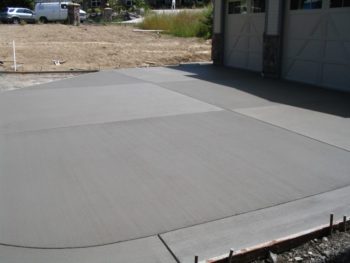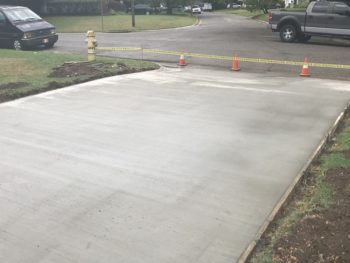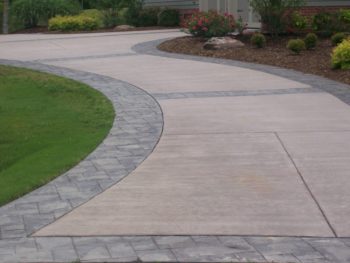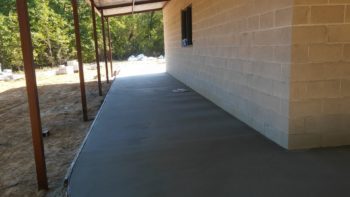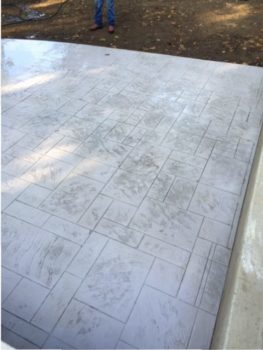Replacing Cracked Concrete in Houston | A Homeowner’s Guide
Replacing a Cracked Driveway in Houston? Here’s What to Know
A cracked driveway or patio does more than just hurt your home’s curb appeal. It can be a tripping hazard, a drainage nightmare, and a sign of deeper issues. For Houston homeowners, our unique climate presents special challenges for concrete surfaces. If you’re looking at a web of cracks spreading across your concrete, it might be time for a replacement.
This guide will walk you through why concrete fails in the Houston area, the benefits of starting fresh with a new installation, and what the replacement process looks like. We’ll also cover how to find a trustworthy local contractor and keep your new concrete looking great for years to come.
Why Does Concrete Crack in Houston?
Concrete is tough, but it’s not invincible, especially in our part of Texas. Several local factors contribute to cracks, shifting, and crumbling.
The Problem with Gumbo Soil
Houston is famous for its expansive clay soil, often called “gumbo soil.” This type of soil acts like a sponge. When it rains, the soil swells with moisture. During dry spells, it shrinks and hardens. This constant cycle of expansion and contraction puts immense pressure on the rigid concrete slab above it, leading to stress fractures and uneven settling.
Intense Heat and Humidity
The relentless Houston sun can heat concrete to extreme temperatures. This causes the slab to expand. When a sudden thunderstorm brings a cool downpour, the rapid temperature change can cause thermal shock, resulting in cracks. High humidity also slows the curing process for new concrete, which can weaken the final product if not managed correctly.
Heavy Rain and Poor Drainage
Houston is no stranger to heavy rainfall. If your property doesn’t have proper drainage, water can pool on or under your concrete driveway or patio. This standing water can erode the soil base underneath the slab, creating voids. When the weight of a vehicle or even just the slab itself is no longer supported, the concrete will crack and sink.
Tree Roots
Mature trees add beauty and shade to your property, but their roots can be destructive. As large tree roots grow, they can push up against the underside of a concrete slab with incredible force, causing it to lift and crack.
Benefits of Replacing Your Cracked Concrete
Patching small cracks can be a temporary fix, but when you’re dealing with extensive damage, a full replacement offers significant long-term advantages.
- Boosts Curb Appeal and Property Value: A smooth, new driveway instantly enhances your home’s appearance. It’s one of the first things visitors or potential buyers see, and a pristine surface makes a powerful first impression.
- Improves Safety: Large cracks, potholes, and uneven sections are serious tripping hazards for your family and guests. A new, level surface eliminates these risks.
- Solves Underlying Issues: A full replacement allows a contractor to address the root cause of the failure. This means they can properly grade the area, install a stable sub-base, and ensure proper drainage to prevent the same problems from happening again.
- Provides a Long-Term Solution: While patchwork might buy you a year or two, a professionally installed new driveway or patio is built to last for decades, giving you peace of mind and saving you money on future repairs.
The Concrete Replacement Process: Step-by-Step
Replacing a driveway or patio is a major project, but a professional crew can handle it efficiently. Here’s what you can expect.
Step 1: Demolition and Removal
The first step is breaking up the old, damaged concrete. The crew will use jackhammers and other heavy equipment to demolish the existing slab. All the broken concrete and debris are then loaded and hauled away, leaving you with a clean slate.
Step 2: Site Preparation and Grading
This is the most critical stage for ensuring the longevity of your new concrete. The crew will evaluate the soil and add and compact a new sub-base material, like crushed rock or gravel. They will precisely grade the entire area to ensure water flows away from your home’s foundation and off the slab.
Step 3: Forming and Reinforcement
Wooden forms are set up around the perimeter to hold the wet concrete in the desired shape. To add strength and prevent cracking, a grid of steel rebar or wire mesh is placed within the forms. This reinforcement helps the slab resist the pressures from soil movement and temperature changes.
Step 4: Pouring and Finishing
The concrete truck arrives, and the crew pours the wet concrete into the forms. They work quickly to spread it evenly, ensuring it fills every corner. Next, they use special tools to smooth and level the surface. They will also add control joints—planned grooves that encourage the concrete to crack in a straight, clean line if it comes under stress. Finally, they apply a finish, such as a traditional broom finish, which adds texture for slip resistance.
Step 5: Curing and Sealing
The concrete now needs to cure, which is a chemical process of hardening. This takes about 28 days for full strength, but you can typically walk on it after 24-48 hours and drive on it after 7-10 days. Your contractor will advise you on the specific timeline. After it’s fully cured, applying a quality sealant is highly recommended to protect the surface from moisture, oil stains, and UV rays.
Choosing a Reliable Concrete Contractor in Houston
The success of your project depends heavily on the contractor you hire. Here are some tips for finding a reputable professional in the Houston area.
- Check for Local Experience: Hire a contractor who understands Houston’s soil and climate challenges. Ask them how they prepare the sub-base to handle our gumbo soil.
- Verify Insurance and Licensing: Ensure the contractor carries general liability insurance and workers’ compensation. This protects you from any liability in case of accidents on your property.
- Ask for a Detailed, Written Estimate: The quote should break down the costs for demolition, materials, labor, and any other expenses. Be wary of estimates that seem unusually low.
- Review Their Portfolio and References: Ask to see photos of their previous work. A confident contractor will also be happy to provide references from past clients in the Houston area.
- Discuss the Project Details: Make sure you are clear on the project timeline, payment schedule, and what warranties they offer on their workmanship.
Maintaining Your New Concrete Driveway or Patio
Once your new concrete is installed, a little maintenance goes a long way in preserving its appearance and integrity.
- Seal it Regularly: Re-apply a high-quality sealant every 2-3 years to protect the concrete from water penetration and stains.
- Clean Spills Immediately: Clean up oil, grease, and other chemical spills as soon as they happen to prevent them from soaking into the concrete and leaving a permanent stain.
- Keep it Clean: Regularly sweep away leaves and debris. Pressure wash the surface annually to remove built-up dirt and grime.
- Avoid Using Harsh Chemicals: Never use de-icing salts on your concrete in the rare event of a Houston freeze. These chemicals can eat away at the surface.
Replacing a cracked concrete driveway or patio is a worthwhile investment in your home’s safety, value, and beauty. By understanding the process and choosing the right Houston-area professional, you can get a durable, attractive surface that will stand the test of time.
